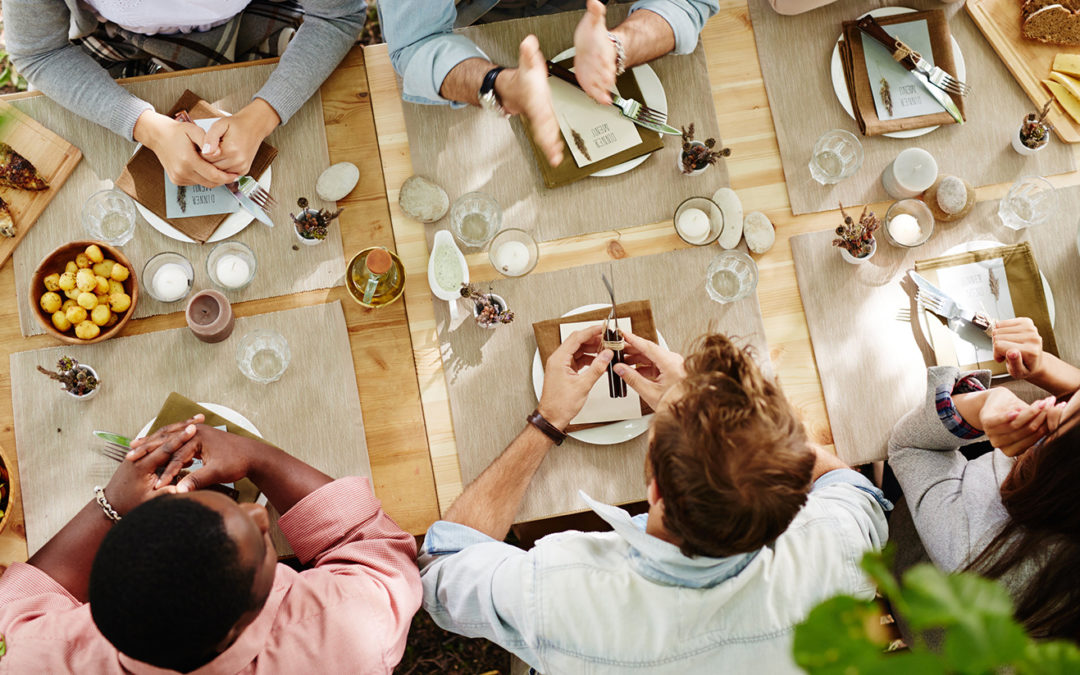Written by Janet Ervin
When we moved into our new house several years ago, one of the first big purchases we made was an extra-large dining room table. And until COVID hit, we regularly filled that table with family, friends, neighbors, work acquaintances, former college roommates, and on one occasion, the guy who came to fix our washing machine. It’s one of the things I miss most from the last couple of years – Zoom just isn’t the same. The conversations ranged from warm and familial to thought-provoking to downright awkward – but it was never boring and we almost always learned something new. My husband and I made it one of our house rules early on to ‘always set an extra place’ and it’s a value that has brought a lot of life to our house over the years.
As we work on social good projects, we regularly allude to ‘bringing people to the table.’ Or sometimes, “If you don’t get invited to the table, go ahead and build your own.” I think the idea of bringing people to the table has positive, hospitable intention behind it and in many cases it’s an acknowledgement that for many years, not everyone in our communities have even received an invitation to conversations that impact them for years to come.
And while it’s a helpful analogy, I’m not sure that it’s exactly right. No matter how many chairs I add to my dining room table, when I host gatherings, I’m still the one who controls the menu, the guest list and more. When our businesses and nonprofits ‘bring people to the table,’ are we considering these issues?
- Whose table is it?
- How do we decide who gets a seat?
- Who decides what is on the agenda – and what is most important?
- How do we make sure that a variety of opinions are being heard, even if they may be uncomfortable or new?
At its best, the table is a place of thought-provoking and challenging conversations between a diverse set of minds that lead to real curiosity and change. But I wonder if sometimes we have become so used to the concept that it becomes a place of comfort, or even a barrier between real conversation.
I think it’s time to evolve the table.
I’ve had too many positive experiences at tables to abandon it altogether – but I do want to challenge myself to consider other ways that voices are included. Here are some practical things our team plans to do this year to make sure we are authentically including voices from across the community:
- Consider the invitation list. This is an easy mistake to make. We develop our networks and it can become easy to rely on these voices but they aren’t always the ones closest to the solution. The pre-pandemic On the Table events did this well by bringing together groups of people across the community to discuss social capital. The focus was listening and fostering better understanding among a range of people. As we develop new campaigns and plans this year, it is our team’s intention to seek this same diversity of thought – and to listen well.
- Foster kinship. Listening well can be a huge challenge. We’ve all faced this at our own tables – everyone has that cranky uncle that wants to monopolize the conversation. This often looks like seeking out people with differing perspectives, then taking the time to really take the time to find out where they are coming from. As Next Stage approaches our own work this year, we plan to lean hard into the concept of community voice, seeking out and fostering relationships with a whole range of community residents.
- Ask the hard stuff. Of all the What’s Next? episodes we’ve done, this conversation with Tommy Tomlinson, Ju-Don Marshall and Alicia Bell is the one that most sticks with me. We talked a lot about what it looked like to ask the right questions and to give someone the space to own their own narrative. Often, we head to the ‘table’ with our own agenda, preconceived notions and solutions – and we ask the questions that will ultimately validate those takes. When we drop the preconceptions and ask the hard stuff, we will likely encounter some hard conversations, but leaning into those talks can lead to more authentic conversation and a greater sense of belonging for everyone involved. This year, I’m taking a hard look at the questions I’m asking, then focusing on giving enough space for an honest answer.
As for the table – I’m not sure what the final evolution should look like, but as I talked it through with my team, we envisioned a warm, welcoming space where everyone involved feels a sense of belonging and connection. Maybe instead of the formal table, it’s time to consider a big potluck where everyone can bring their chairs, their favorite dish and their authentic selves.
Tell us – what do you envision this table to look like?
